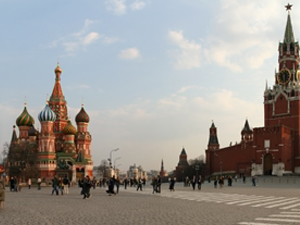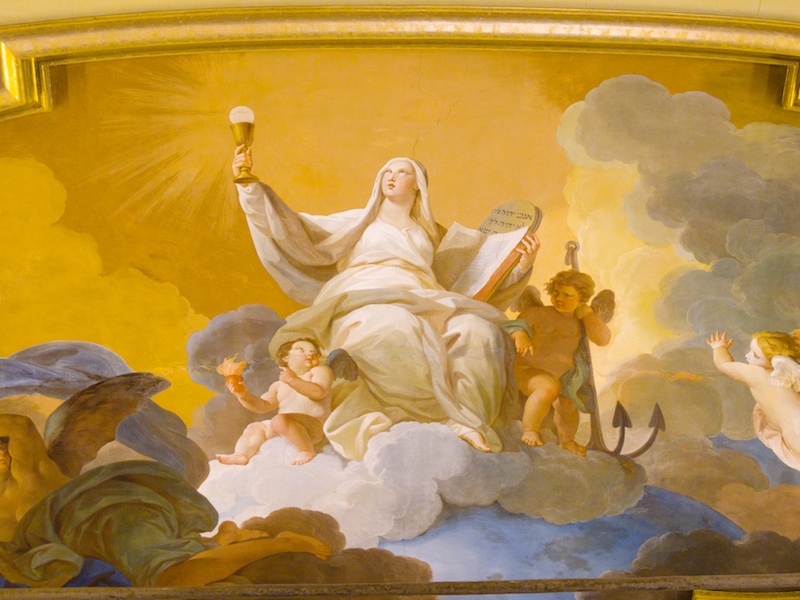“Two Romes have fallen, but the third stands, and a fourth there will not be.” —The Russian Monk Philotheus, c. 1520, referring to Rome, Constantinople (“New Rome”) and Moscow
“In the afternoon Tatiana stayed indoors and read from the prophets Amos and Obadiah…
“Commandant Yurovsky got up from his chair, went out on to the landing and rang the bell at the double doors of the Romanov’s sitting room. It was 1:30 in the morning of 17 July, 1918…
“Yurovsky, having finished reading the decree, pulled out his Colt, stepped forward and shot the Tsar at point-blank range in the chest. Ermakov, Kudrin and Medvedev, not to be outdone… immediately took aim and fired at Nicholas as well, followed by most of the others, propelling an arc of blood and tissue over his terrified son beside him.
“For a moment the Tsar’s body quivered on the spot… Then he quietly crumpled to the floor.
“But at least Nicholas was spared the sight of seeing what happened to his wife and family…” —Helen Rappaport, The Last Days of the Romanovs: Tragedy at Ekaterinburg (2008), describing the murder of Tsar Nicholas II and his family on July 17, 1918
“None of the Romanov girls — those pretty girls whom none of the guards had really wanted to have to kill — died a quick or painless death. Maria had been felled by a bullet in the thigh… and was now lying on the floor moaning…. Her three sisters suffered terribly, filling the room with their screams as they shrieked out for their mother, Olga and Tatiana doing what came instintively, pressing themselves into each other’s arms in the darkest corner for protection. Realising that the two girls were still alive, Ermakov lunged at them with the eight-inch bayonet he had stuffed in his belt, stabbing at their torsos. But, drunk and  uncoordinated as he was, he had trouble penetrating the girls’ chests… Incredibly, Yurovsky now saw that the Tsarevich was still alive… In the end Yurovsky pulled a second gun from his belt to give the dying boy the coup de grace… Alexey’s body then finally slumped and rolled silently against that of his father.” —Ibid.
uncoordinated as he was, he had trouble penetrating the girls’ chests… Incredibly, Yurovsky now saw that the Tsarevich was still alive… In the end Yurovsky pulled a second gun from his belt to give the dying boy the coup de grace… Alexey’s body then finally slumped and rolled silently against that of his father.” —Ibid.
“There was no beauty to see in the dead.” —One of the Russians who buried the bodies of the Tsar and his children, referring to the bloody appearance of the four girls, cited by Rappaport
“If my requests are heeded, Russia will be converted, and there will be peace; if not, she will spread her errors throughout the world, causing wars and persecutions of the Church. The good will be martyred; the Holy Father will have much to suffer; various nations will be annihilated. In the end, my Immaculate Heart will triumph. The Holy Father will consecrate Russia to me, and she shall be converted, and a period of peace will be granted to the world.” —The Second Secret of Fatima, spoken in an apparition by the Virgin Mary to three children in Fatima, Portugal, on July 13, 1917
Re-reading the history of the Russian revolution, I am struck by its sheer rage and brutality, summed up in the murder, not of the Tsar, Nicholas II, or even of the Tsaritsa, Alexandra, brutal as that was, but of their five children.
The family was imprisoned in a house in Ekaterinburg for several months in 1918, then killed — shot and bayoneted to death — in the basement of that house on the morning of
July 17, 1918.
The author of a 2008 book on the last days of the Tsar and his family, the British writer Helen Rappaport, spent many months in Ekaterinburg, a city on the eastern slope of the Urals where the Tsar and his family were imprisoned in the months before they were executed.
She read many local Russian accounts of what happened in 1918, and she has stitched them together into a gripping narrative filled with details unavailable elsewhere.
It is a narrative one wishes one could alter.
A tale one wishes one could change… so that the children are not killed. At the last moment, an airlift to rescue them, to lift them out of the Ipatiev house somehow…
But there is an evil in human affairs that gets the upper hand.
Mysterium iniquitatis.
“The mystery of iniquity,” St. Paul called it — the mystery of evil.
I write this partly in the fear that it could all happen again. Not the same thing, but similar things.
And, though the past (of course) cannot be altered — what’s done can’t be undone — yet the future may be within our power to influence, just a little.
Perhaps we can act in such a way that children are not shot and bayoneted to death, in our time, and time to come.
Or is there never to be “a time of peace,” of the putting away of bayonets — at very least, for children — in our world?
All the prophets, and also the message Lucy heard at Fatima, speak of a coming “time of peace.”
Is it just a dream? Will the prophecies never be fulfilled? It would be something worth working for, and living for, and sacrificing for.
Russia in 1918
The descriptions of the beginnings of the Russian revolution make one shudder.
One can sense that social conventions are being overturned, that zeal for revolution is running roughshod over ordinary human kindness.
When the revolution came to Ekaterinburg in 1918, Rappoport writes, “shops were vandalised, their windows smashed; others were closed down, their goods confiscated and their owners ruined… The hotels one by one shut their doors… Civic institutions and businesses lost their educated and skilled workers, many of whom were hounded out as class enemies, thus ensuring, counter-productively, that there was nobody left with the expertise to run them… Phone lines were cut and the handsets thrown in the river. Societies and clubs were banned and all public meetings, except Communist ones, forbidden. One by one, the city’s fine civic buildings fell into neglect, their windows cracked and dirty, their floors unswept and muddied by dirty boots…. People were now being arrested indiscriminately, on the slightest suspicion of counter-revolution. When the prisons were full, hotels and factories were taken over as places of internment.”
And she adds: “Bolshevik venom was in particular directed at the clergy — 45 members of the Ekaterinburg Orthodox diocese were murdered that summer — shot, drowned, bayoneted, their eyes gouged out, tongues and ears hacked off and their mangled bodies thrown in the river.”
In the end, millions of believers were to suffer at the hands of the communists, who desired to eliminate “God” from their society.
And so “Holy Russia” became a different country, with a different name: the Soviet Union. And the Orthodox faith in Russia was persecuted violently.
Then, after the horrors of Stalinism — millions exiled and executed — and of the Second World War — more millions killed — came the still somewhat mysterious collapse of the Soviet system in 1989-1991, and “Russia” re-emerged into history.
But which Russia?
“Ekaterinburg today,” Rappaport writes, “is becoming hostage to big business as it rushes headlong to a market economy…”
(Lenin would roll over in his grave.)
“More and more of its neglected historic buildings are being torn down to make way for offices and expensive apartment blocks. Gift shops, fast food, and the most fashionable of Western clothes are now available at shopping malls such as Vainer Street, where the ear is assaulted by tinny and obtrusive disco music…
She continues: “Out at Ganina Tama, where Yurovsky oversaw the hasty consignment of the bodies to the mineshaft that first night… one gets an overwhelming sense of the emotional dynamic of a story that, for the faithful, has now been set in stone as a national tragedy encapsulating everything Russia has lost… Ganina Yama is the obligatory place of pilgrimage for any Russian believer, and the high point for any foreign tourist visiting what Russian tour websites now call ‘the Romanov Golgotha’… evocative images of the Imperial Family inevitably twist and turn into view. No matter how one tries to resist, they nag at one’s consciousness… a boy in a sailor suit… girls in white dresses… untainted, murdered children… a devoted family destroyed… all of them now forever young, forever innocent and, as they all so fervently wished for in their many prayers, ‘at rest with the saints’.”
Russia’s Role
As a student of Church history at Yale from 1980 to 1984, my professor, Dr. Jaroslav Pelikan, the respected historian of the development of Christian doctrine, once told me he felt that it was critical for the “two lungs” of Christianity, east and west, to “breathe together” again.
“Unless that happens,” he told me, “I think the West will fall.”
Not that Christianity would disappear, but that the Christian West, as the Christian West, would be no more.
I took his words as the indication of a path. For some years now I have been trying, in my own, limited way, to understand the causes of the divisions between eastern and western Christians, and to help to overcome them, in the hope of helping to defend the West from its own self-destruction, and to hand on what has been handed down to us.
And this has meant seeking to reconcile the “three Romes” — Rome, Constantinople, and Moscow.
From the Orthodox point of view, the first Rome, the capital of the Roman empire and the center of the Church, did not fall only to the barbarians, but also to heresy. The Orthodox believe Rome altered the Orthodox faith, by inserting the “filioque” clause into the Creed, and so cut herself off from the true Church. This was one key reason for the “Great Schism” of 1054, and for the mutual excommunications which were uttered at that time by the Pope of Rome and the Patriarch of Constantinople.
And so Christianity was divided into two: the east and the west, the Greek and the Latin, the Orthodox and the Catholic. (Those mutual excommunications were lifted in 1965, but that has not brought about actual reunion, which still seems quite far off.)
The Second Rome, according to the Orthodox view, was Constantinople. It fell when it was conquered by Muslims in the 1400s (in 1453, to be exact).
As for the Third Rome, Moscow, the Orthodox believe it fell to militant “humanist” atheism in 1917.
So, to quote the words of the monk Philotheus, does the Third Rome stand? Or, did it fall, and is it now standing up again?
The Third Rome has had the major responsibility for Orthodoxy since the fall of Constantinople in 1453. But this vision of a Russian mission to preserve the Orthodox faith has been repeatedly compromised by a tendency to link that holy mission with a secular one: the mission to make Russia a strong, powerful state — nationalism.
Tragically, those who had a broader vision of the Orthodox world, like Patriarch Nikon in the 1600s, were deposed, and from 1700 on the Russian Church found itself controlled by a Department of State on the Protestant model. The aim was to reduce Orthodoxy to a mere national ritualism of outward observance. And that is still a danger today.
As in the West, the arrival of the Enlightenment age brought new challenges in Russia, and the understanding of the Church Fathers was submerged beneath the knowledge of German philosophy and Western technology. Both the Catholic and the Orthodox Churches confront this as a continuing challenge.
Soviet Communism — as Russian Orthodox Patriarch Kirill has eloquently noted — proclaimed the supremacy of Russia without Orthodoxy, replacing the Third Rome by the Third International. The Communists behaved like Orthodox, but without Christ; they were delighted to be “Christ-less.”
That phase of history is past. Communism fell 20 years ago. But what is the situation of the faith in Russia, really?
The scars which Communism left are everywhere clearly visible. Everywhere, alcoholism, everywhere, sexually transmitted diseases and abortion, everywhere, ecological catastrophe, everywhere, crime, injustice and intimidation, everywhere, the rule of the mafia or mafias.
The communists destroyed thousands of churches, and now thousands have been rebuilt.
But is Russia “converted”? Is Russia now oriented toward Christ, in the same way that she for 70 years was oriented away from Him, “Christ-less”?
I cannot answer these questions.
Meanwhile, two things are happening: (1) in Rome, the Pope is extending a hand of warm welcome to the Russians; at the same time, (2) the Russian Orthodox are traveling far and wide around the world and extending their own hand of friendship toward Catholics and even toward Protestant evangelicals.
So something is happening. What… is still not clear.
Dr. Robert Moynihan
Note to readers: Consider joining Dr Robert Moynihan, editor and founder of Inside the Vatican magazine, in Italy for Easter on our annual Holy Week pilgrimage (only a few seats left). We also will have a small pilgrimage for those wishing to attend the beatification of Pope John Paul II on May 1. We are also planning a small pilgrimage to Russia in July. For more information please call 904.699.0960 or email pilgrimage@insidethevatican.com or visit: http://insidethevatican.com/pilgrimage.htm#easter2011



